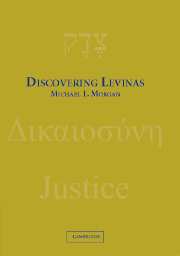Book contents
- Frontmatter
- Contents
- Preface
- Acknowledgments
- 1 Auschwitz, Politics, and the Twentieth Century
- 2 Phenomenology and Transcendental Philosophy
- 3 The Ethical Content of the Face-to-Face
- 4 Philosophy, Totality, and the Everyday
- 5 Meaning, Culture, and Language
- 6 Subjectivity and the Self
- 7 God and Philosophy
- 8 Time, Messianism, and Diachrony
- 9 Ethical Realism and Contemporary Moral Philosophy
- 10 Beyond Language and Expressibility
- 11 Judaism, Ethics, and Religion
- Conclusion: Levinas and the Primacy of the Ethical – Kant, Kierkegaard, and Derrida
- Appendix: Facing Reasons
- Bibliography
- Index
9 - Ethical Realism and Contemporary Moral Philosophy
Published online by Cambridge University Press: 05 June 2012
- Frontmatter
- Contents
- Preface
- Acknowledgments
- 1 Auschwitz, Politics, and the Twentieth Century
- 2 Phenomenology and Transcendental Philosophy
- 3 The Ethical Content of the Face-to-Face
- 4 Philosophy, Totality, and the Everyday
- 5 Meaning, Culture, and Language
- 6 Subjectivity and the Self
- 7 God and Philosophy
- 8 Time, Messianism, and Diachrony
- 9 Ethical Realism and Contemporary Moral Philosophy
- 10 Beyond Language and Expressibility
- 11 Judaism, Ethics, and Religion
- Conclusion: Levinas and the Primacy of the Ethical – Kant, Kierkegaard, and Derrida
- Appendix: Facing Reasons
- Bibliography
- Index
Summary
ETHICS AND THE EVERYDAY
There are many questions that arise when we ask ourselves what Levinas's philosophy has to do with ethics. In Chapter 3, we considered the content of the face-to-face, and we saw that it is a dimension of everyday social interaction that involves the brute particularity of the I and the other person insofar as the other person calls the I into question and demands that the I take responsibility for him and be responsive to him. This relationship, then, is a plea for goodness and justice and a demand for kindness and generosity. When, as Levinas puts it, the other calls out to me, “Thou shalt not murder” – which means acknowledge me, accept me, help me to live, and respond to my needs – this sounds ethical, and Zygmunt Bauman, in his book Postmodern Ethics, associated it with the central theme of Knud Løgstrup's book The Ethical Demand. But what does it mean to call the face-to-face “ethical,” and what does Levinas mean by saying that ethics is first philosophy? In what sense is this central aspect or dimension of human existence “ethical?”
Furthermore, the face-to-face is not a theory. If it is associated with ethics, what does it have to do with ethical or moral theory? Is it akin to or associated with some meta-ethical theory, say, moral realism of one kind or another?
- Type
- Chapter
- Information
- Discovering Levinas , pp. 228 - 299Publisher: Cambridge University PressPrint publication year: 2007



